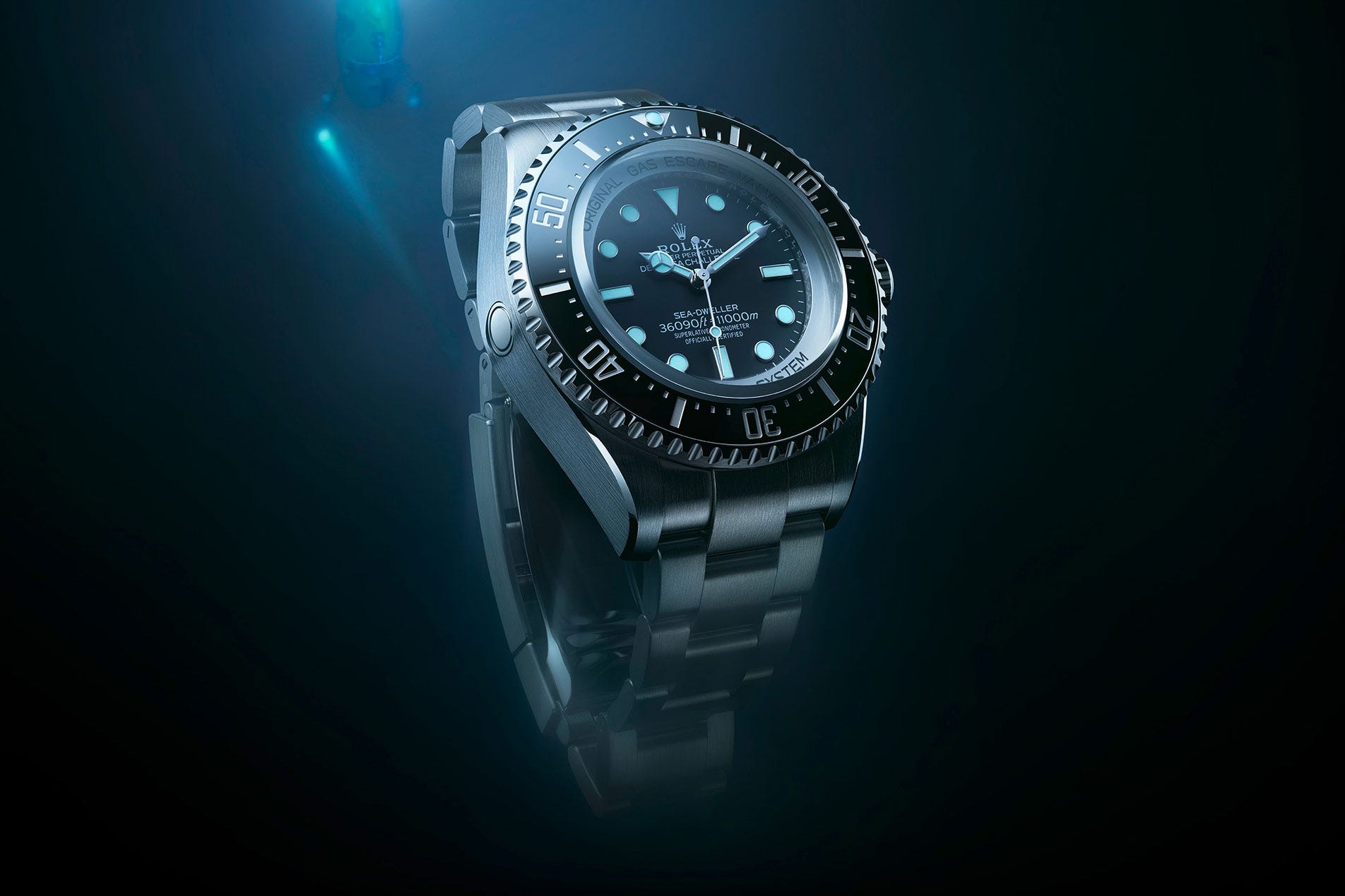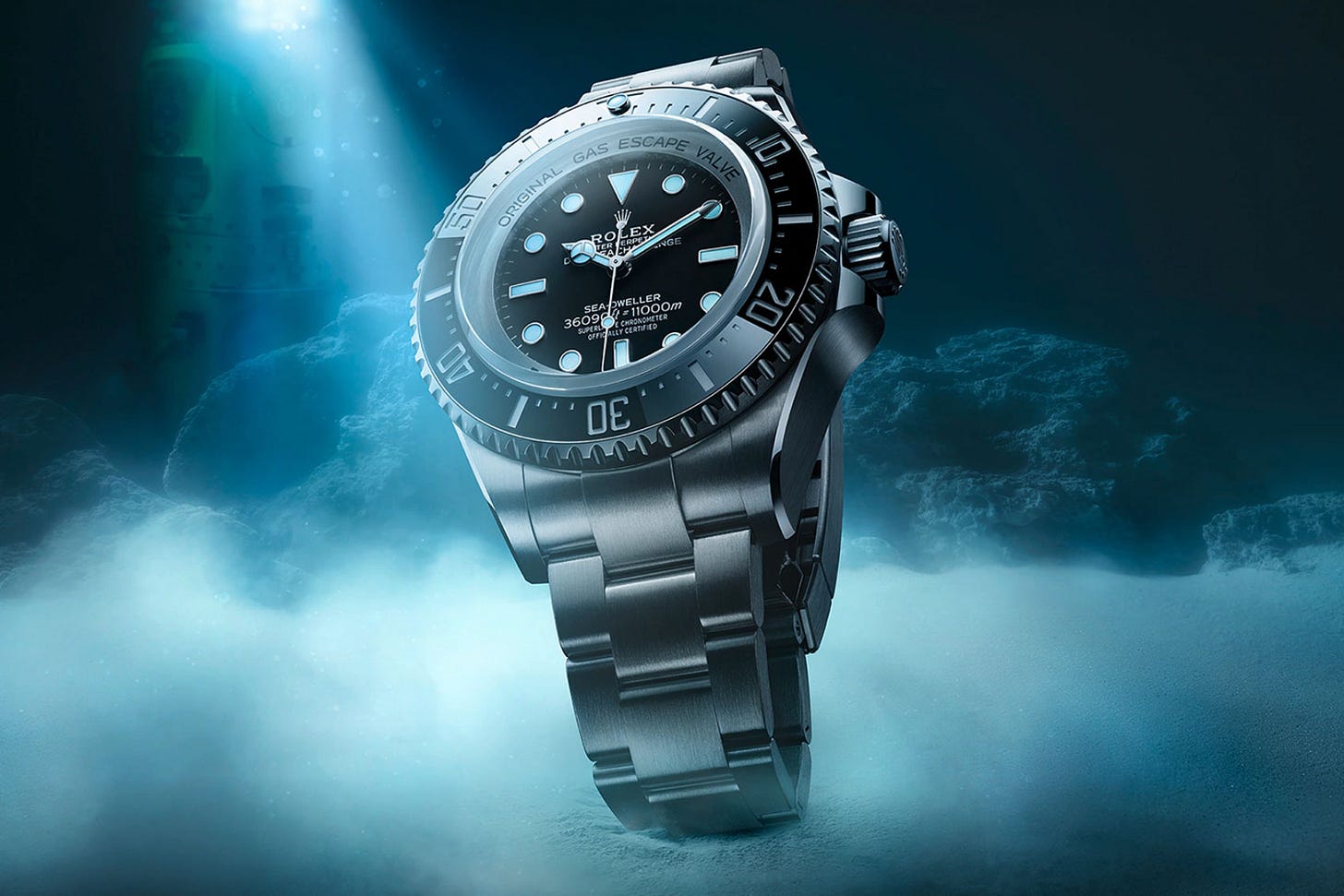The Rolex Titanium Deepsea Challenge: Specs Fetishism, A Theory Of Charismatic Megafauna, And Mr. George Thorogood And The Delaware Destroyers
"This one goes to eleven." – This Is Spinal Tap
So here’s the thing. When the Rolex announced the titanium Deepsea Challenge I had several reactions, more or less at once.
The first was that the whole thing was faintly ridiculous. The Challenger Deep has been the brass ring for ultra-deep water resistance watches since humans first started diving on it, and it just doesn’t feel all that interesting anymore, to make a watch that can go that deep and survive the pressure. Rolex did it, in fact, in 1960 when it strapped a Deep Sea Special to the bathyscaphe Trieste and sent it all the way down to the bottom-most bottom: 10,916 meters. Since then there have been several watches which have been rated to that depth – the Bell & Ross Hydromax, for instance, which although it is not a purist’s fave, with its quartz movement and silicone oil-filled case is still rated to 11,100 meters; Omega’s Ultra-Deep concept watches were all three of them good to 15,000 meters … you go a little numb after a while.
There is an exo-planet called WASP 76-B where it may be that it rains molten iron; if Rolex or Omega or whoever had a mind to, I’m sure they could make a watch that could survive a dip into the atmosphere of such a world as long as they didn’t give a toot or a tinkle about whether or not it was (a) wearable and (b) had any actual practical relevance to a watch anyone would really want and be able to wear, or afford to buy.
The second was that there might be something else going on here, and this is where it gets a little kinky. For as long as I have been writing about watches I have suspected them of being slightly (or not so slightly) fetishistic. Fetishism is in psychology the substitution of a particular part of the body or of an article of dress for the person as a whole, as anyone who was ambushed by a certain moment in House Of The Dragon can attest. (I hasten to add that I judge no one nor anything when it comes to whatever floats your boat. You do you.) In watches (to move with discreet haste to another subject) I have often wondered if there is not a kind of specs fetishism – certainly the Brands, god love ‘em, seem to play to it, well beyond the domain of what actually matters in daily life. Depth ratings and antimagnetic ratings especially seem to attract no end of fascination.
And, here is the key point, they attract fascination primarily insofar as they are expressions of magnitude, entirely apart from whether or not those magnitudes are at all relevant to an actual human owner experience. Taken to its extreme specs fetishism can (at least on the assumption it’s actually a thing) obscure the ability to consider the watch as a whole and at its most severe it can lead to reactions like, “LOL Dufour Simplicity has 30m water resistance, in a modern watch wtf thank you I will stick with my 200m water resistant SKX007.” You stop seeing the watch as a whole and the spec in question starts to become a substitution for experiencing all the aspects of the watch.
In the end, though, I have come to feel that there is something simpler and altogether more innocent going on. We are, simply, fascinated by magnitude – what is the biggest, what is the smallest, what is the oldest, and so on; why, Buzzfeed could hardly exist if we were not.
To illustrate, let us look at the phenomenon of so-called charismatic megafauna. These are animals which are so impressively enormous as to outshine their smaller brethren – the mouse, Mus musculus, is of incredible value as an indispensable member of its ecosystem but one struggles to imagine a world in which it outshines the elephant in our collective imagination. This is even more clear when you think about endangered species – the notion of polar bears or tigers vanishing forever is grief-inducing thing to consider in a way that the extermination of the physically unprepossessing snail darter is not.
So it is with over-spec’d wristwatches. A watch able to withstand depths out of reach of all but the most exotic manned submersibles is impressive, not for its practical value, but simply for the size of the number of its depth resistance. We are fascinated with dinosaurs not out of any fetishistic impulse (except perhaps for those for whom dinosaurs stir the loins in a way best left to the imagination … you know who you are) but simply because of their epic, antediluvian size. Very few people will tell you that their favorite dinosaur is the robin-sized Parvicursor remotus; plenty of people will tell you, if you ask, that it’s T. rex or one of the giant sauropods, like the aptly named Ultrasaurus.
The point, therefore, of a dive watch rated to 10,000 meters (or what have you) is not that it is more practical. The point of such a watch is simply to be waterproof to 10,000 meters, and to evoke childlike awe in doing so. In a way, this is, rather than some exercise in pointless maximalism on the part of a brand, one of the most pure of all pleasures in watchmaking. I’m reminded of another dinosaur, which exists for no other reason than to provide the simplest and most visceral of pleasures …
Come on take a little walk with me baby/and tell me who do you love?






I just imagine Rolex sitting in a meeting going "and I wept for there were no more worlds to conquer...wait did Omega just release a watch that that withstand 15,001 meters!? break out the drafting table boys meat is back on the menu" ;-)